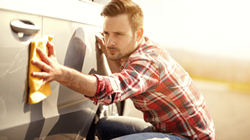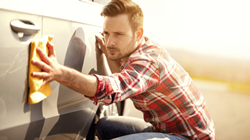
KEEPING YOUR CAR CLEAN DURING THE CORONAVIRUS OUTBREAK
ST. PETERSBURG, Fla. (PRWEB)
August 08, 2020
By now, we all know that there are two good ways to fight COVID-19. One is to wash your hands for at least 20 seconds with plenty of soap and warm water.
The other is to disinfect high touch surfaces, according to the CDC.
When we think of high touch surfaces, things like door handles, your phone, and remote controls might come to mind.
But what about your car?
While you might not think of your car as you think of the door handle, chances are it’s just as gross.
According to a recent study by CarRentals.com – your car’s steering wheel plays host to over 6x the bacteria of your phone, and nearly double that of the typical elevator button.
Normally, that’s gross enough on its own, but considering the ongoing Coronavirus pandemic, it’s even more concerning than usual.
If for some reason you’re still driving your car, then it certainly can’t hurt to disinfect your car’s high touch surfaces including:
-
Steering wheel - Door handles
- Shift levers
- Buttons and touch screens
- Wiper and turn signal levers
- Armrests
- Grab handles
- Seat adjusters
- Cupholders
- Sunglass holders
- Seat
- Dashboards/molding
This is a must if you’re a rideshare driver or live in an area with a high concentration of cases. It’s worth doing even if you don’t, considering how dirty your car can get.
With that in mind – the CDC recommends daily disinfection of high touch surfaces, including your car.
Whether that’s something you want to take in stride or not – if you’re using your car, you should attempt to disinfect it at least 2-3 times a week.
The peace of mind is worth it, right?
Cleaning your car’s surfaces is a little bit different than cleaning your countertops. Bleach or hydrogen peroxide, for instance, will both kill the Coronavirus, but they’ll also leave your car’s interior looking less than ideal.
For example, bleach (or any bleach-based cleaner) will destroy the color of your car’s upholstery if you use it.
The same goes for hydrogen peroxide.
Ammonia and alcohol-based cleaners, on the other hand, can damage your touch screens and other electronics.
As you can see, cleaning your car is not as simple as you would think.
Besides just bleach and hydrogen peroxide, there are several other cleaners commonly associated with disinfecting you want to avoid as well.
These disinfectants can either damage your interior or are not proven to kill the Coronavirus, according to the CDC guidelines.
- Acetone
- Steam
- Listerine
- Vinegar
- Essential Oils
- Lemons
Although these may work for other bacteria, you should not use them to clean your car for any reason. For a complete list of disinfectants, please visit the CDC’s master list.
Before You Clean Your Car
Disinfecting your car should always start with you protecting yourself. We highly recommend you wear rubber gloves that are separate from your dishwashing gloves if possible.
Wearing a separate pair of gloves will help keep your hands clean, and help you avoid spreading anything from outside.
After you finish disinfecting your car, you should also make sure you wash your hands per the recommended CDC method.
Cleaning Non-Leather, Hard Surfaces (Metal, Plastic, and Glass)
Your non-leather, hard surfaces are things like:
- Your door handle and trunk handle
- Plastic molding
- Your cupholders and sunglass holders
- Your shift levers
- Armrests (if they aren’t cloth or faux/real leather)
- Your steering wheel (if it isn’t faux/real leather)
They do NOT include:
- Touch Screens & Other Electronics
Cleaning Options:
- Isopropyl alcohol (70%)
- Soap (Dial or similar hand soap) and Water
- Lysol/Clorox Wipes (that don’t contain bleach)
- Lysol/Clorox Sprays (if you apply an even coating)
Non-leather hard surfaces include can be cleaned with isopropyl alcohol. According to the CDC, if you use a spray or wipes that contain at least 70% alcohol, you’ll be in good shape.
Isopropyl also won’t damage your electronics either.
If you don’t happen to have Isopropyl on hand, you have other options too.
Soap and water will also work – and it’s considered effective, according to the CDC. Scrub down all non-leather surfaces with a mixture of soapy water and a soft cloth in order to be most effective.
The friction combined with the soap and water helps to destroy the protective envelope around the Coronavirus. Soap and water is also the safest option for non-leather interiors as well.
You can also use Lysol and Clorox wipes, both of which will kill the Coronavirus. You should use wipes instead of sprays, if possible because spray disinfectants won’t always completely cover what you use them on.
Those areas that the spray misses can make them less effective.
If you do choose to use a disinfectant spray, make sure you spray an even coating.
Non-Leather, Soft Upholstery (Cloth/Faux Leather)
- Isopropyl alcohol (70%)
- Soap (Dial or similar hand soap) and Water
- Lysol/Clorox Wipes (that don’t contain bleach)
If your car has fabric or faux leather upholstery, you’ll want to be careful to only use Isopropyl, soap, and water, or a disinfectant wipe if you have Faux Leather.
Isopropyl is the preferred choice here for its relative ease of use. Wet a soft cloth with the alcohol and work it over the surface of your choice. It’s best to rotate the cloth around in order to avoid simply pushing around the germs.
You can also go with soap and water instead – which is also effective. The only thing to keep in mind with soap and water is to be careful not to soak cloth upholstery with water, as that can lead to mold building up.
You also want to avoid suds building up – as suds will stay around forever on cloth, although this is less of a problem on faux leather.
Finally, Clorox and Lysol wipes will also work well on faux leather and cloth.
Leather Surfaces
- Soap (Dial or similar hand soap) and Water
- Isopropyl alcohol (70%)
- Recommended: Leather conditioner
Leather requires delicate treatment to avoid damage. The best way to clean leather is to use a bit of dish soap and water on a microfiber cloth. Using a regular cloth can sometimes scratch the leather if you have debris on it.
Work the soap and water gently over the leather. Don’t rub too hard – as you can discolor the leather if it’s dyed.
After washing, make sure to use a good leather conditioner to protect your leather. Using leather cleaner will help preserve your leather for the long term by keeping it moist and supple.
In a pinch, you can also use Isopropyl alcohol to clean your leather but do so sparingly if possible.
Over time, cleaning your car’s leather with Isopropyl can damage or discolor it. Alcohol will dry out the leather – so it’s essential that you use leather conditioner after to prevent it from staying dry.
Touch Screens & Other Electronics
- 70% Isopropyl alcohol
- 70% Isopropyl alcohol wipes
- Recommended: Microfiber Cloth
Touch screens and other electronics should not be cleaned like the other surfaces in your car. The big difference is how you clean them.
You should NEVER apply liquids directly to any touch screens or other electronics. You should also use a microfiber cloth if possible, although a regular, soft, lint-free cloth will also work.
Alcohol wipes will work, as well. We recommend first wiping down the touch screen with a microfiber cloth to pull away any debris that might end up scratching the screen.
Protect My Car can help you with all your car repair needs.

